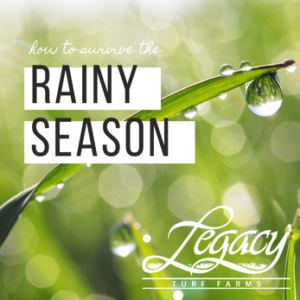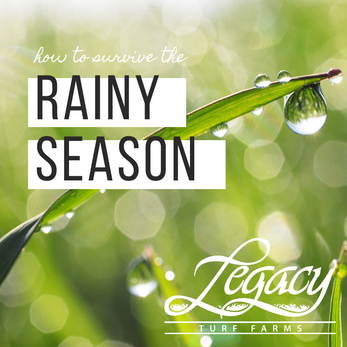 You can’t remember the last time you’ve enjoyed a dinner out on the patio, or even a fire in the backyard fire pit. Your neighborhood creek is at its highest water level in years. There are ducks swimming in places that ducks never used to be. And they even cancelled school for flooding roads!
You can’t remember the last time you’ve enjoyed a dinner out on the patio, or even a fire in the backyard fire pit. Your neighborhood creek is at its highest water level in years. There are ducks swimming in places that ducks never used to be. And they even cancelled school for flooding roads!
Needless to say, it’s a frustrating time for outdoor enthusiasts. Rainfall is at nearly double the amount of typical rainfall totals year to date. Many homeowners have seen front or back yards flooding, and many more yards are still soggy with standing water. What does all of this excess water mean for your beloved lawn? Well, it could make it more susceptible to disease, stress, or damage. To get you ahead of the curve, we’ve put together some of the most tried and true methods to make sure your lawn survives the rainy season.
Have these tips at hand for keeping your lawn healthy, even in an extra rainy spring season:
1. Watch for Disease
One thing that can happen to overly wet grass is fungus. Keep an eye out for particularly dark spots, as this may indicate a fungus has developed. Times like these are when it’s important to have mowed your grass to a short height during the growing season. In a bad case, you may see algae growing. Either way, we need time and sun for the lawn to dry out. If you’re having trouble identifying the issue, our team at Legacy is always available to consult and problem solve with you.
2. Avoid Foot Traffic
Have a family or a dog? Try to avoid using your lawn as a pathway for the time being. When soaked to the root, your grass is especially sensitive to wear and tear. Any footsteps or compression of the grass into the soil could make the grass more prone to injury.
3. Raise Low-Lying Areas
Now that you see where the puddles tend to collect, now is a great time to document these spots so that you can remedy them in the future. Take a picture so you can remember the size and depth of the puddle. Then, once things dry up, you can slowly use a top-dressing method to raise the ground level in that spot. Use a mixture of sand and topsoil to top a layer of ½ inch on the existing healthy grass, and over time the area will elevate itself. Keep in mind this may take more than one application. If you prefer not to go the DIY route, most landscapers can help with grading.
4. Consider replacing or patching over damage
If you’ve done all these things to protect your lawn, and you still have damaged grass, you do have another option. Consider patching or replacing highly damaged areas with new sod. Expertly grown and cared for at our farm, it is sure to be a healthy product in your soil. If you have a warm-season grass (not fescue — we’re talking about bermuda or zoysia), wait until spring green-up to truly assess the damage. From there, we can make a decision on what may need replacement.
5. Get Ahead of the Weeds
From a treatment standpoint, you may be tempted to begin a pre-emergent herbicide on your grass to prevent new weeds from sprouting. But wait — what if that bottle you just purchased goes to waste? If you apply a substance to your lawn while it is waterlogged, the grass is already at capacity — with H2O! When full of water, the soil is unable to soak up additional substances.
The key here is to wait until you have a dry spell for a few days. When you see a break in the forecast from rain, take advantage of it. Then, and only then, is the time to apply a granular or liquid pre-emergent. This way, there is enough air and room in the soil for it to truly absorb the treatment.
6. Be Mindful of Sprinkler Schedules
I have a bluetooth light switch in my house that I love. It turns on my lights just a couple of minutes after I get home from work, and I’m able to enjoy the soft ambience of my favorite lamp in the corner, without climbing over the chair to switch it on. But wait! If your sprinklers are on a timer, we seriously need to reconsider at this time of year. You could be doing more damage to your lawn than you ever intended if the irrigation system is watering in addition to the rainfall that you received that day or week. Even in the winter time and early spring, your lawn needs about 1 inch of precipitation per week. No rain gauge? Check the website www.wunderground.com for rainfall totals by the inch.
AccuWeather’s long-range meteorologist team is anticipating that rainfall will continue to be above average in the Southeast for several more weeks. We hope these tips can help you combat a soggy lawn!
For more questions or to consult about your upcoming project, we’d love to talk things out. Reach out to Emma or Devon in the Legacy office at 770-607-0491.
